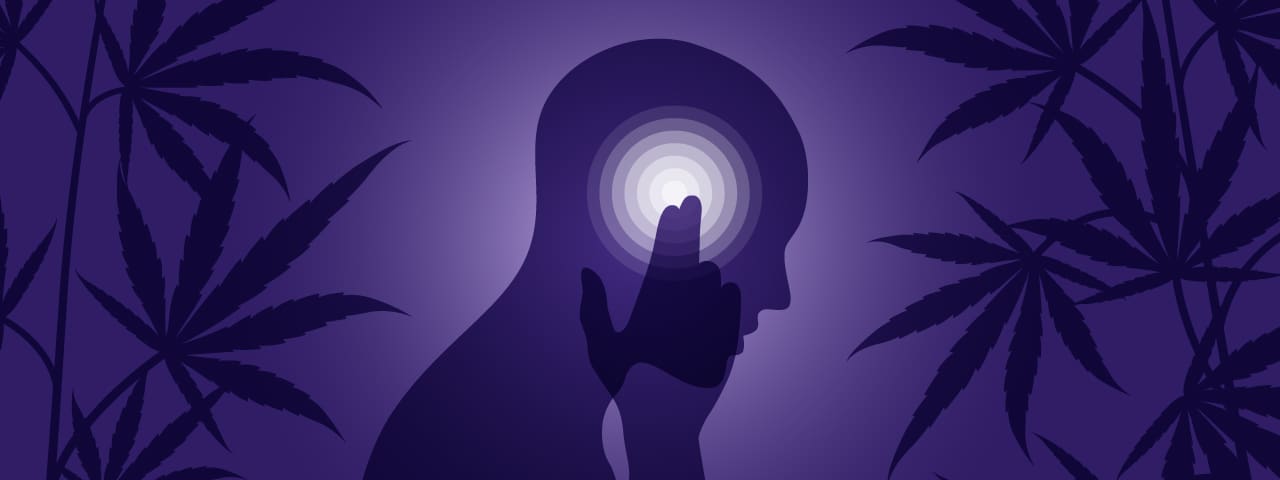The best cannabis strains for migraine relief
7 min read



Migraine headaches can be intense, prolonged, and deeply disruptive. Symptoms often include nausea, sensitivity to light and sound, and fatigue.
While the exact cause of migraine remains unknown, growing evidence and anecdotal reports suggest cannabis may offer relief by reducing pain, inflammation, and stress levels.
Each cannabis strain offers a different balance of cannabinoids and terpenes. These compounds contribute to a strain’s potential effects and might make some strains particularly helpful for managing migraine attacks.
Best strains for migraine
Anecdotal reports suggest that the following strains can help with pain, nausea, and other symptoms related to migraine.
Still, it’s important to remember that your experience with a particular strain may differ from that of others. Finding the best strain for your migraine symptoms may require some trial and error.
Using cannabis to find migraine relief?
Get a personalized care plan from a provider at Leafwell!
- Product recommendations
- Dosing and daily use tips
- Flags for medication interactions

Grandaddy Purple

Grandaddy Purple is a classic indica-dominant strain known for its sedative effects and deep body relaxation. It’s typically used to combat pain, stress, insomnia, and nausea, all common symptoms associated with migraine.
This makes the strain especially well-suited for nighttime relief or when migraine symptoms are at their peak.
- Dominant terpene: Myrcene
- Cannabinoid profile: 17% to 23% tetrahydrocannabinol (THC)
GSC

GSC is an indica-dominant hybrid that offers high THC levels and a blend of uplifting and relaxing effects. It’s often recommended for chronic pain, nausea, and appetite loss, making it a valuable option for migraine relief if you tolerate THC well.
- Terpenes: Beta-caryophyllene, myrcene
- Cannabinoid profile: 25% THC, 1% cannabigerol (CBG)
- Note: Start with a low dose if you’re new to high-THC strains
Blue Dream

Blue Dream is a sativa-dominant hybrid that delivers a gentle cerebral buzz, accompanied by soothing body effects.
It contains more THC than cannabidiol (CBD), but offers a functional and uplifting experience without heavy sedation. This makes it a good choice for managing daytime migraines.
- Terpenes: Beta-caryophyllene, myrcene
- Cannabinoid profile: 18% to 21% THC
- Note: Start with a low dose if you’re new to high-THC strains
Harlequin

Harlequin is a high-CBD strain with a typical 2:1 ratio of CBD to THC.
Its mild psychoactive effects make it a good option for those looking to address migraines early, before symptoms intensify.
The strain’s terpene profile includes anti-inflammatory and pain-relieving compounds that may reduce both the frequency and severity of migraine attacks.
- Terpenes: Myrcene, beta-caryophyllene, pinene, humulene
- Cannabinoid profile: 5% THC, 9% CBD, CBG, cannabidiolic acid (CBDA)
GMO

GMO (aka Garlic Cookies) is an indica-dominant, high-THC strain with sedative properties, making it ideal for late-stage migraine relief or use before bedtime.
Its terpene profile contributes to deep relaxation and may help alleviate tension and insomnia associated with migraine. This strain is best suited for experienced users due to its potency.
- Terpenes: Myrcene, beta-caryophyllene, limonene
- Cannabinoid profile: 28% THC, 1% CBG
- Note: Start with a low dose if you’re new to high-THC strains
OG Shark

OG Shark is a potent indica-dominant hybrid known for its high THC content and strong pain-relieving effects. It’s often recommended for migraine due to its ability to ease both physical discomfort and mental stress. One study found it was the most preferred strain for patients treating pain associated with headaches and migraine.
OG Shark may help reduce inflammation and promote relaxation, which can be especially beneficial during intense or prolonged migraine episodes. Many users report that it also helps with nausea and improves sleep quality.
- Terpenes: Beta-caryophyllene, myrcene
- Cannabinoid profile: 28% THC, CBD, tetrahydrocannabinolic acid (THCA)
- Note: Start with a low dose if you’re new to high-THC strains
Northern Lights

Northern Lights is a classic indica strain renowned for its strong sedative and pain-relieving effects.
Often chosen for its ability to ease physical discomfort and promote sleep, it’s a go-to option for people with migraine who experience symptoms late in the day or struggle with migraine-related insomnia.
This strain is typically high in THC (averaging around 20% or more) and features a calming terpene profile that may help with muscle relaxation and mood stabilization.
- Dominant terpenes: Myrcene, beta-caryophyllene, limonene
- Cannabinoid profile: 18% THC, 1% CBG
OG Kush and Purple Kush
OG Kush and Purple Kush are frequently recommended for managing nighttime migraine symptoms, especially when attacks are accompanied by tension, stress, or sleep disturbances.
Both are rich in myrcene, a terpene known for its sedative and pain-relieving effects, and are valued for their ability to promote deep relaxation and sleep, key components in migraine recovery.

OG Kush is a balanced hybrid with strong indica characteristics. It delivers a combination of mental and physical effects that can help reduce pain, nausea, and stress.
- Dominant terpenes: Myrcene, limonene, beta-caryophyllene
- Cannabinoid profile: 18% to 26% THC
- Note: Start with a low dose if you’re new to high-THC strains

Purple Kush is an indica strain with powerful sedative effects, commonly used to manage pain and induce sleep. It’s particularly helpful during more intense migraine episodes that require full-body relief.
- Dominant terpenes: Myrcene, pinene, beta-caryophyllene
- Cannabinoid profile: 18% to 26% THC
Using cannabis to find migraine relief?
Get a personalized care plan from a provider at Leafwell!
- Product recommendations
- Dosing and daily use tips
- Flags for medication interactions

How does weed help with migraine?
While more research is needed, several studies suggest cannabis may reduce migraine frequency, duration, and severity.
Cannabis may work by:
- Slowing the movement of pain signals in the nervous system
- Reducing inflammation
- Promoting relaxation and sleep
- Supporting mood and appetite during migraine episodes
These effects are largely attributed to the plant’s cannabinoids and terpenes, which vary from strain to strain.
Should you choose indica or sativa for migraine?
The best strain type for migraine symptoms will depend on factors like the time of day and your personal tolerance and preferences.
One study found that hybrid strains were overwhelmingly preferred by patients with migraine. However, there’s no single right answer, and finding what works best for you will depend on your needs.
Here are some general guidelines:
- Indica-dominant strains: Better for evening use and severe symptoms; promote sleep and muscle relaxation
- Sativa-dominant strains: May offer daytime relief through uplifting and energizing effects, but some patients report that sativas do not work well for migraine symptoms
- CBD-rich hybrids: Provide pain relief with less intense psychoactive effects; may be suitable for those who are sensitive to THC
“It took me years to dial in on how to treat myself for migraines. It’s very strain-specific, at least for me,” says Riley Kirk, PhD, a cannabis researcher and advocate who lives with migraine.
For Dr. Kirk, indica-dominant varieties like GMO are ideal during migraine attacks, whereas sativa strains are not. “When I have a migraine, sativas make it worse. I can feel my brain pulsing, and it gets worse when I consume those varieties,” she adds.
Best cannabinoids for migraine
Certain cannabinoids may help ease migraine attacks thanks to their unique properties:
- CBD is non-intoxicating and offers anti-inflammatory and neuroprotective benefits.
- CBG may reduce inflammation and support brain health.
- Cannabichromene (CBC) shows potential for its anti-inflammatory effects.
- THC can relieve pain, promote sleep, and stimulate appetite.
However, when it comes to THC, there are some important things to know.
At first, THC helps by calming the brain’s pain signals. However, over time, if you use high levels of THC, your brain starts to adjust and becomes less sensitive. You build tolerance, so you need more THC to get the same relief.
This is important because THC affects serotonin and calcitonin gene-related peptide (CGRP), two chemicals that help control:
- Pain signals
- Headaches
- Blood vessel swelling in the brain
Normally, the brain maintains a balance between these two chemicals. But too much THC over time can lower serotonin and increase CGRP, which means more inflammation, pain, and frequent headaches.
A 2020 study found that cannabis, especially varieties high in THC, was linked to more frequent medication-overuse headaches in people with migraine.
So, using more THC doesn’t always mean more relief; it can sometimes mean more pain in the form of rebound headaches. When THC wears off, your headaches may come back stronger or more often than before due to chemical imbalances in the brain.
Best terpenes for migraine
- Myrcene: Pain relief, muscle relaxation, sleep promotion
- Beta-caryophyllene: Anti-inflammatory, stress relief
- Linalool: Calming, anxiety-reducing
- Humulene: Anti-inflammatory, potential appetite suppressant
- Pinene: Clear-headed effects, anti-inflammatory
- Limonene: Mood support and anti-nausea
Best ways to use cannabis for migraine
Along with choosing a strain that may help with migraine, you can tailor your cannabis consumption to treat your symptoms more effectively:
- For fast pain relief, try inhalation: Smoking or vaping cannabis offers the fastest relief of pain, usually within minutes. This may be ideal when migraine symptoms come on suddenly.
- For longer-lasting relief, consider edibles: When you eat or drink cannabis products, you’ll experience long-lasting effects, making them good options for prevention or longer migraine episodes.
- For flexible dosing, use tinctures and oils: These cannabis forms absorb quickly when placed under the tongue and offer flexible, precise dosing methods.
- Apply topicals to the face or neck: Topical formulas may help with tension headaches, but are less effective for deep migraine pain.
- Start low and go slow: If you’re new to using cannabis or trying a product for the first time, always start with a low dose and increase it slowly over time as needed, until you achieve your desired effects. This is especially important for high-THC products and strains.
- Time your dose strategically: You can plan for your cannabis dose’s effects to peak at different times depending on when and how you consume. For example, you may want to take a dose earlier in the day for migraine pain relief and one later in the day for appetite or sleep support.
Using cannabis to find migraine relief?
Get a personalized care plan from a provider at Leafwell!
- Product recommendations
- Dosing and daily use tips
- Flags for medication interactions

The bottom line: Certain cannabis strains can help with migraine management
Cannabis may offer significant relief for people with migraine by addressing both acute symptoms and potential triggers like stress and sleep disruption.
From high-CBD strains like Harlequin to indica strains like Grandaddy Purple, there’s a wide range of options depending on your needs, preferences, and THC sensitivity.
Always consult a medical professional to personalize your treatment plan and ensure cannabis is a safe choice for your migraine care.
Get Your Medical Card
Connect with a licensed physician online in minutes.
Larger purchase limits Access to higher potency strains Save up to 40% on product taxes Enhanced legal protection
Resources
- Efficacy and safety of medical marijuana in migraine headache: A systematic review. https://pmc.ncbi.nlm.nih.gov/articles/PMC9845509/
- Medical cannabis, headaches, and migraines: A review of the current literature. https://pmc.ncbi.nlm.nih.gov/articles/PMC8459575/
- Migraine frequency decrease following prolonged medical cannabis treatment: A cross-sectional study. https://www.mdpi.com/2076-3425/10/6/360
- Patterns of medicinal cannabis use, strain analysis, and substitution effect among patients with migraine, headache, arthritis, and chronic pain in a medicinal cannabis cohort. https://thejournalofheadacheandpain.biomedcentral.com/articles/10.1186/s10194-018-0862-2
- Short- and long-term effects of cannabis on headache and migraine. https://www.jpain.org/article/S1526-5900(19)30848-X/fulltext
Frequently asked questions
Learn more about using cannabis for migraine with answers to common questions.


